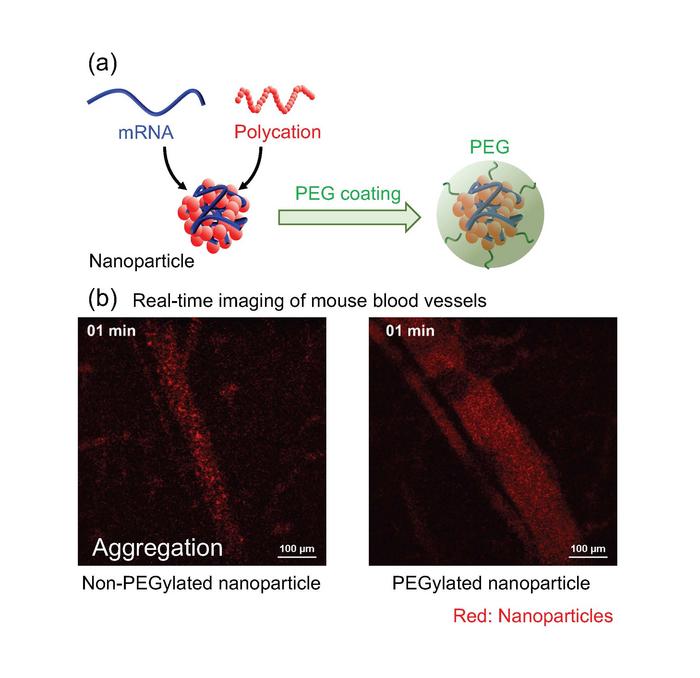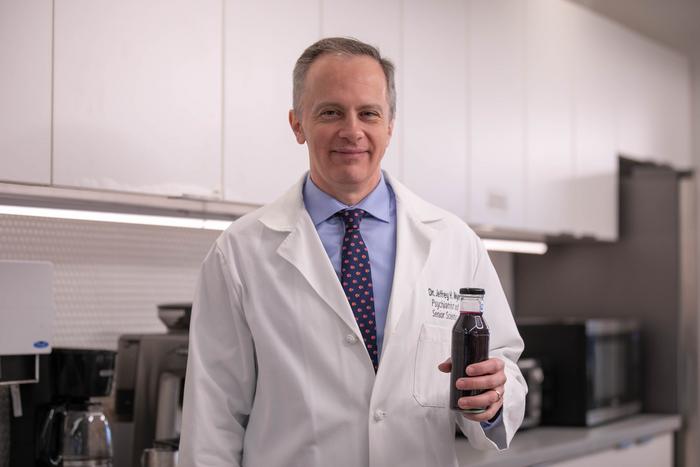Credit: Image courtesy of CAMH. All rights reserved.
A new study published in the Lancet discovery science journal eClinicalMedicine has confirmed that a novel natural supplement—invented, researched, developed and commercialized at the Centre for Addiction and Mental Health (CAMH)—prevents postpartum blues, and reduces symptoms of postpartum depression over the following six months after giving birth.
Up to 8 out of ten new mothers experience postpartum, or ‘baby,’ blues, characterized by mood swings, crying spells, anxiety and difficulty sleeping. The condition usually begins within the first few days after delivery and may last for up to two weeks. Postpartum blues strongly raises the risk of postpartum depression, a serious mental illness affecting 13 per cent of mothers. Postpartum depression has important health care consequences: impairing quality of life, increasing risk for future depressive episodes and suicide, and is associated with cognitive and emotional effects in children. Until now, options for widespread prevention have been lacking for either condition.
The study, entitled Dietary Supplement for Mood Symptoms in Early Postpartum: A Double-Blind Randomized Placebo Controlled Trial, involved more than 100 postpartum participants between January 2019 and December 2022 who either took four doses of the natural supplement several days after giving birth, or a matching placebo. Within the supplement group, two-thirds (66 per cent) experienced either no symptoms or only negligible symptoms of postpartum blues. Furthermore, in the following six months, participants who received the supplement experienced less symptoms of depression with none reaching the clinical threshold of postpartum depression six months after giving birth.
“Globally 140 million births take place every year. Most women then experience postpartum blues, which, when severe, increases the likelihood of getting full-blown postpartum depression at least fourfold. Our study showed that both postpartum blues and later symptoms of depression were lower in women who received the dietary supplement,” said Dr. Jeffrey Meyer, inventor of the nutraceutical and study senior author. “Providing this specialized dietary support in the first few days after giving birth is a crucial window to avoid depressive symptoms which is tremendously important given there is considerable risk that they may recur and have lifelong impact.”
Dr. Meyer has been investigating postpartum blues for more than 15 years. His previous imaging research found that a protein called MAO-A rises dramatically in the brains of postpartum women and this protein removes important brain chemicals—like serotonin and dopamine—that support normal mood. It also acts as an oxidant and is linked to the development and progression of certain mental illnesses. To combat this effect, the nutraceutical is made up of a patented unique combination of natural ingredients, including blueberry extract, which contain antioxidants, and amino acids that replenish essential neurochemicals in the brain to support healthy mood and the ability to concentrate under stress. The supplement was well tolerated and women who took it tended to report less symptoms, in part due to less drowsiness, headache and restlessness. The researchers previously showed that the amino acids in the supplement do not affect their total concentrations in breast milk, which was expected since these amino acids are already found in proteins in breast milk.
CAMH has partnered with international women’s health supplement and pharmaceutical company Exeltis via a licensing agreement to bring the product to market under the name Blues Away®. Exeltis has maintained the natural health product approach in their preparations and manufacture for widespread distribution of the supplement. It is expected that the product will be available for sale in the U.S. beginning April 11, 2024. It is also in the process of being brought to other global markets—including Canada—with the pace of approvals being dependent on each country’s regulatory requirements and reviews.
“We are thrilled to unveil the culmination of years of dedication and collaboration in the form of our groundbreaking nutraceutical for postpartum blues prevention. It is great that we are able to simultaneously share our clinical research around this product while also partnering with a global women’s health industry leader to make it available to the new mothers who need it,” said Klara Vichnevetski, Director of Industry Partnerships and Technology Transfer. CAMH has nurtured this innovation from its inception, guiding it from bench to bedside where it can make an immediate and profound difference in the lives of millions of women and their families.”
A limitation of the study was that, of the several measures of depression in the study, the supplement did not demonstrate the expected protective effect in an experimental test that involves inducing low mood with sad stimuli, although it is possible that the stress of the COVID-19 pandemic and moving the setting of the study to participant’s homes during the pandemic may have influenced the results of this particular test.
Aristotle Voineskos, Vice President of Research, added: “Two major pillars of our CAMH approach to research are the importance of integrating scientific findings into advancing mental health care and the value of early intervention. Through the perseverance and dedication of our researchers and technology transfer team, this novel preventative therapy may contribute to best practice when it comes to postpartum care and help women around the world avoid more serious and chronic mental illness.”
This research was funded by CAMH, with some additional funding from Exeltis.
-30-
About the Centre for Addiction and Mental Health (CAMH)
CAMH is Canada’s largest mental health and addiction teaching hospital and a world leading research centre in this field. CAMH combines clinical care, research, education, policy development and health promotion to help transform the lives of people affected by mental illness and addiction. CAMH is fully affiliated with the University of Toronto, and is a Pan American Health Organization/World Health Organization Collaborating Centre. For more information, please visit camh.ca or follow @CAMHnews on Twitter.
Media Contact:
CAMH Media Relations
media@camh.ca
Journal
EClinicalMedicine
DOI
10.1016/j.eclinm.2024.102593
Method of Research
Randomized controlled/clinical trial
Subject of Research
People
Article Title
Dietary supplement for mood symptoms in early postpartum: a double-blind randomized placebo controlled trial
Article Publication Date
10-Apr-2024
COI Statement
JHM is the inventor on patents for the dietary supplement and there is
an agreement between CAMH and Exeltis for the latter to manufacture,
and distribute the dietary supplement. JHM also has patents for blood
biomarkers in mood disorders to predict neuroinflammation, elevated
MAO-B level and elevated MAO-A level in the brain. JHM has received
operating grant funding from Exeltis and Sanofi in the past 2 years.
MIH receives research grants from the Canadian Institutes of Health
Research, CAMH Foundation, University of Toronto, COMPASS
Pathfinder; stipend from Society of Biological Psychiatry; payment or
honoraria from the American Society of Clinical Psychopharmacology
and American College Health Association; consulting fees from Wake
Network Inc. and stock options in Mindset Pharma Inc.









































